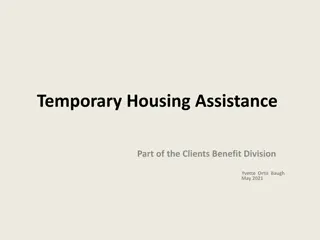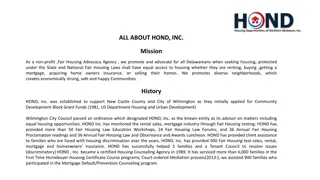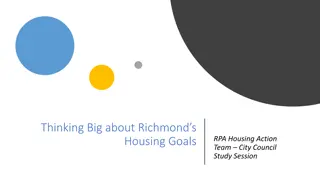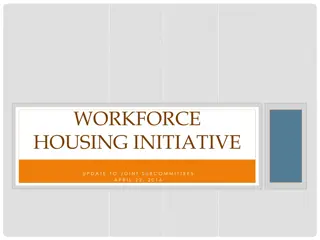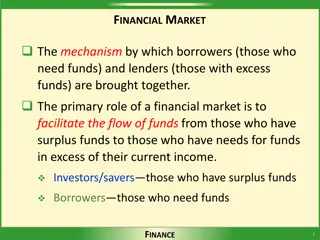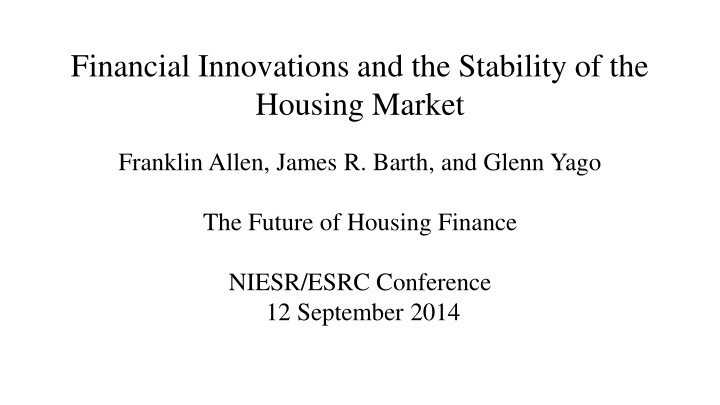
Impact of Financial Innovations on Housing Markets
The history of financial innovations' influence on housing markets, exploring developments in the UK and US, the evolution of modern US housing finance, and sources of funding for home purchases. Insights on system improvements.
Download Presentation

Please find below an Image/Link to download the presentation.
The content on the website is provided AS IS for your information and personal use only. It may not be sold, licensed, or shared on other websites without obtaining consent from the author. If you encounter any issues during the download, it is possible that the publisher has removed the file from their server.
You are allowed to download the files provided on this website for personal or commercial use, subject to the condition that they are used lawfully. All files are the property of their respective owners.
The content on the website is provided AS IS for your information and personal use only. It may not be sold, licensed, or shared on other websites without obtaining consent from the author.
E N D
Presentation Transcript
Financial Innovations and the Stability of the Housing Market Franklin Allen, James R. Barth, and Glenn Yago The Future of Housing Finance NIESR/ESRC Conference 12 September 2014
I. Introduction Over the years financial innovations have had a significant effect on housing markets We consider the history of innovations and this interaction in a number of countries What went wrong and how can the system be fixed? 2
II-III. Early History in the UK and US John Wood and son in Bath, England: model for urban real estate development In the US home ownership accompanied reform and expansion of land ownership for farming By 1890 2/3 of all farm housing was owner occupied 3
US homeownership rate, 1900-2012 Q2 Percent 75 70 65 60 55 50 45 40 4
IV. Development of Modern US Housing Finance First Savings and Loan organized in 1831 and gradually spread around the country Granted tax advantages and developed separately from banking system In the 1930s S&Ls did not suffer runs because they did not take demand deposits but they did suffer withdrawals to maintain consumption and this caused failures In 1932 Federal Home Loan Bank System set up and in 1934 FSLIC 5
After World War II the Savings and Loan Sector prospered growing from 3% of private financial assets in 1945 to 16% in 1975 As interest rates fluctuated wildly in the late 1970s and early 1980s the Saving and Loan sector was put under severe strain Many failed and regulation was changed so they were able to become much more similar to commercial banks 6
V. Sources of Funding for Home Purchases and Homeownership Rates 100% 90% Private-label backed mortgage pools Other 80% Agency- and GSE-backed mortgage pools 70% 60% 50% 40% GSE-home mortgages Savings institutions and credit unions 30% 20% 10% Commercial Banks 0% 7
Sources of funding for home mortgages in selected countries, 2009 Percent 100 90 80 70 60 50 40 30 20 10 0 Deposits Mortgage bonds, including covered bonds Residential mortgage-backed securities Institutional investors Other 8
Covered bonds in selected countries, 2010 Mortgage-backed covered bonds outstanding US$ Billions 500 457 446 450 400 350 295 300 275 269 253 250 200 150 94 100 55 39 37 36 50 27 15 14 13 11 8 5 1 0.1 0 9
Mortgage-backed covered bonds as percent of residential loans outstanding Percent 100 100 80 67 60 50 44 40 32 31 25 25 25 24 21 19 20 14 13 12 8 6 2 1 0.7 0.1 0 10
Homeownership rates in various countries around the world Selected countries, 2009 Percent 100 89 90 84 83 82 82 77 77 80 75 74 71 68 68 67 67 66 70 64 62 61 60 50 38 40 30 20 10 0 11
European Union and other selected countries, 2010 Percent 98 100 93 91 87 87 87 90 86 85 85 81 81 81 80 80 79 78 77 77 80 75 75 74 70 69 67 70 66 66 59 58 58 60 56 54 50 43 40 30 20 10 0 12
Home mortgage debt to GDP in various countries around the world Selected countries, 2009 Percent 140 130 120 100 81 78 80 71 62 60 60 36 40 22 21 15 20 10 7 5 3 2.1 2.1 1.7 1 0 13
European Union countries, 2010 Percent 107 110 101 100 87 85 90 82 80 69 66 70 64 60 47 46 45 50 44 42 42 41 36 35 40 28 25 30 23 22 19 17 20 14 13 12 6 10 0 14
VI. Federal Government Involvement in Mortgage Markets Since the 1930s the federal government has played an increasingly important role in the allocation of mortgage credit Loan insurance and guarantees: Fannie Mae, Freddie Mac, Ginnie Mae US is one of relatively few countries in which the government provides support to residential mortgage markets 15
Government support for mortgage markets Country Government mortgage insurance Government security guarantees Government sponsored enterprises Denmark No No No Germany No No No Ireland No No No Netherlands NHG No No Spain No No No United Kingdom No No No Australia No No No Canada Canada Mortgage Housing Corporation Canada Mortgage Housing Corporation No Japan No Japan Housing Finance Agency Possible South Korea No No Korean Housing Finance Corporation Switzerland No No No United States FHA GNMA Fannie Mae, Freddie Mac, FHLBs 16
Total mortgages outstanding as percentage of US GDP Percent 90 80 70 60 50 40 30 20 10 0 17
Total home mortgages outstanding and share of home financing provided by government- sponsored enterprises in the US US$ trillions Percent 14 60 GSE share of home financing (Right axis) 12 50 10 40 8 30 6 Total home mortgages outstanding (Left axis) 20 4 10 2 0 0 18
Date of first mortgage-backed securitization Year Country 1970 United States 1984 Australia and Canada 1985 United Kingdom 1988 France 1989 South Africa 1991 Spain 1995 Germany and Ireland 1996 Argentina 1999 Brazil, Japan, Italy and South Korea 2000 India 2003 Mexico 2004 Malaysia 2005 China 2006 Russia and Saudi Arabia 19
Percentage of bank assets in residential real estate loans (2010) New Zealand Estonia Netherlands South Africa Samoa (Western) Poland Switzerland Latvia Chile United States El Salvador Sierra Leone United Kingdom Belgium Fiji Venezuela Hungary Belarus Cayman Islands Bulgaria Iceland Guyana Serbia Isle of Man Panama Bosnia and Herzegovina Dominican Republic Gibraltar Trinidad and Tobago Uruguay Singapore China Malta Nigeria Burundi Puerto Rico Mauritius Russia Palestinian Territory Jersey Argentina Belize Thailand Swaziland Ghana Jamaica Lesotho Angola 0% 5% 10% 15% 20% 25% 30% 35% 40% 45% 50% 20
Percentage of securitized residential real estate loans (2010) Seychelles Puerto Rico Guatemala Netherlands Belgium Colombia Italy Canada United States Greece Mexico Australia Brazil Iceland Malaysia New Zealand Zimbabwe Virgin Islands, British Vanuatu Uruguay Syria Swaziland South Africa Slovenia Singapore Sierra Leone Samoa (Western) Peru Palestinian Territory Namibia Mauritius Malta Lithuania Lesotho Kenya Jersey Jamaica Israel Isle of Man Indonesia India Hungary Honduras Guyana El Salvador Dominican Republic Cyprus Croatia Costa Rica Cook Islands Burundi Botswana Bosnia and Herzegovina Armenia Angola 0% 10% 20% 30% 40% 50% 60% 70% 80% 90% 100% 21
VII. Turmoil in global housing markets: Implications for the future of housing finance The residential mortgage market in the United States has worked extremely well over the past two centuries, enabling millions to achieve the dream of homeownership. But there have been periods of turmoil The Great Depression The late 1970s and early 1980s The current period 22
Home prices peak in 2006 and subsequently decline (1991 Q1 2012 Q2; Index, 1991 Q1=100) 350 S&P/Case-Schiller Home-Price Index 10-Metro-Composite 300 250 200 150 100 OFHEO/FHFA Seasonally Adjusted Purchase-Only Index 50 0 23
Housing Problems in a Number of Countries Average house price changes (Rankings of countries in parentheses) Country Boom (1998:Q1-2006-Q2) Bust (2006:Q2-2011:Q3) Overall (1998:Q1-2011:Q3) Similar to the United States? United States Australia Belgium 49.9 (15) 78.5 (7) 55.2 (11) -22.6 (2) 17.7 (17) 12.4 (14) 16.0 (16) 110.1 (3) 74.4 (7) - No No Canada 53.3 (13) 28.5 (19) 96.9 (4) No Denmark 79.5 (6) -19.5 (4) 44.6 (13) Yes Finland 68.4 (8) 2.7 (11) 72.9 (8) No France 102.2 (4) 5.1 (12) 112.6 (2) No Germany -11.4 (18) -5.7 (9) -16.5 (18) No Ireland 131.4 (1) -25.3 (1) 72.9 (9) Yes Italy 53.4 (12) -7.9 (6) 41.2 (14) Yes Japan -25.6 (19) -8.3 (5) -31.8 (19) No Netherlands 61.0 (10) -6.9 (8) 49.8 (12) Yes New Zealand 64.2 (9) -1.7 (10) 61.4 (11) Yes Norway 53.0 (14) 24.3 (18) 90.2 (6) No South Korea 4.4 (17) 6.5 (13) 11.1 (17) No Spain 108.6 (3) -20.8 (3) 65.3 (10) Yes Sweden 83.4 (5) 16.0 (16) 112.9 (1) No Switzerland 10.7 (16) 14.2 (15) 26.4 (15) No United Kingdom 112.2 (2) -7.3 (7) 96.6 (5) Yes 24
VIII. Future Innovations in Housing Finance Diversifying sources of capital (debt and equity) Structuring financial products that will promote private capital investment to support residential real estate construction, maintenance, and sustainable improvement Diversifying types of housing products (single/multiple family) 25
Higher density, sustainable buildings that increase housing consumers cash flow and ability to service long-term debt Pooling savings and risk-management products Credit enhancement Using information technology to monitor and improve efficiency in housing finance 26
Financing Housing: Back to the Future Aligning interests of private capital funders with policy incentives Create a diversified housing stock by eliminating the bias against subsidies for renters Pooling savings to create investment vehicles Using credit enhancement and guarantees to manage real estate risks 27
Creating flexible capital structures for residential developments through structured finance Regulating land use to limit supply constraints. Restoring the role of private investors (domestic and international) as drivers of homeownership and financing. Restoring confidence in securitization through mortgage- backed securities and covered bonds. 28






